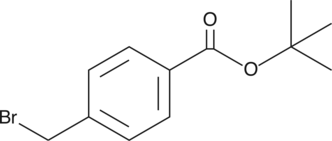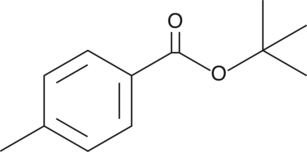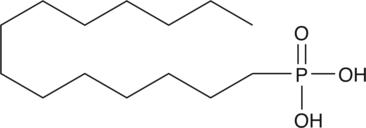Chemicals
Showing 37651–37800 of 41137 results
-
Terphenyllin is a flavonoid metabolite originally isolated from A. candidus that has antibacterial and cytotoxic properties.{38478,38480} It is active against methicillin-resistant S. aureus 1 (MRSA-1), MRSA-2, and V. vulnificus (MICs = 31.27-31.47 µg/ml) and cytotoxic to HeLa, A549, and HepG2 cells (IC50s = 18.87, 12.33, and 21.2 µM, respectively).{38480} Terphenyllin inhibits HIV-1 integrase in coupled and strand transfer assays with IC50 values of 17.7 µM and 47.7 µM.{38479}
Brand:CaymanSKU:23480 - 1 mgAvailable on backorder
Terphenyllin is a flavonoid metabolite originally isolated from A. candidus that has antibacterial and cytotoxic properties.{38478,38480} It is active against methicillin-resistant S. aureus 1 (MRSA-1), MRSA-2, and V. vulnificus (MICs = 31.27-31.47 µg/ml) and cytotoxic to HeLa, A549, and HepG2 cells (IC50s = 18.87, 12.33, and 21.2 µM, respectively).{38480} Terphenyllin inhibits HIV-1 integrase in coupled and strand transfer assays with IC50 values of 17.7 µM and 47.7 µM.{38479}
Brand:CaymanSKU:23480 - 5 mgAvailable on backorder
Terpineol is a monoterpene alcohol that has been found in a variety of plants, including Cannabis, and has diverse biological activities.{42314} Terpineol contains the four isomers α-, β-, and γ-terpineol and terpinen-4-ol. α-Terpineol has antibacterial and antinociceptive properties.{45018,45019} It is active against a variety of periodontopathic and cariogenic bacteria, including strains of P. gingivalis, F. nucleatum, and A. actinomycetemcomitans (MICs = 0.1-0.8 mg/ml), however, it is toxic to KB cells when used at a concentration of 0.8 mg/ml.{45018} It also reduces mechanical hyperalgesia, as well as spontaneous and palpation-induced nociception, in a mouse model of cancer-induced pain beginning on day 5 when administered at a dose of 50 mg/kg per day.{45019} Terpinen-4-ol has anticonvulsant properties, inhibiting pentylenetetrazol-induced seizures in mice when used at doses ranging from 50 to 200 mg/kg.{45020} α-Terpineol and terpinen-4-ol also have anti-inflammatory properties, reducing LPS-induced production of IL-1β, IL-6, and IL-10, but not TNF-α, in U937 cells.{45021} This product is a mixture of α-, β-, and γ-terpineol.
Brand:CaymanSKU:23173 - 1 gAvailable on backorder
Terpineol is a monoterpene alcohol that has been found in a variety of plants, including Cannabis, and has diverse biological activities.{42314} Terpineol contains the four isomers α-, β-, and γ-terpineol and terpinen-4-ol. α-Terpineol has antibacterial and antinociceptive properties.{45018,45019} It is active against a variety of periodontopathic and cariogenic bacteria, including strains of P. gingivalis, F. nucleatum, and A. actinomycetemcomitans (MICs = 0.1-0.8 mg/ml), however, it is toxic to KB cells when used at a concentration of 0.8 mg/ml.{45018} It also reduces mechanical hyperalgesia, as well as spontaneous and palpation-induced nociception, in a mouse model of cancer-induced pain beginning on day 5 when administered at a dose of 50 mg/kg per day.{45019} Terpinen-4-ol has anticonvulsant properties, inhibiting pentylenetetrazol-induced seizures in mice when used at doses ranging from 50 to 200 mg/kg.{45020} α-Terpineol and terpinen-4-ol also have anti-inflammatory properties, reducing LPS-induced production of IL-1β, IL-6, and IL-10, but not TNF-α, in U937 cells.{45021} This product is a mixture of α-, β-, and γ-terpineol.
Brand:CaymanSKU:23173 - 10 gAvailable on backorder
Terpineol is a monoterpene alcohol that has been found in a variety of plants, including Cannabis, and has diverse biological activities.{42314} Terpineol contains the four isomers α-, β-, and γ-terpineol and terpinen-4-ol. α-Terpineol has antibacterial and antinociceptive properties.{45018,45019} It is active against a variety of periodontopathic and cariogenic bacteria, including strains of P. gingivalis, F. nucleatum, and A. actinomycetemcomitans (MICs = 0.1-0.8 mg/ml), however, it is toxic to KB cells when used at a concentration of 0.8 mg/ml.{45018} It also reduces mechanical hyperalgesia, as well as spontaneous and palpation-induced nociception, in a mouse model of cancer-induced pain beginning on day 5 when administered at a dose of 50 mg/kg per day.{45019} Terpinen-4-ol has anticonvulsant properties, inhibiting pentylenetetrazol-induced seizures in mice when used at doses ranging from 50 to 200 mg/kg.{45020} α-Terpineol and terpinen-4-ol also have anti-inflammatory properties, reducing LPS-induced production of IL-1β, IL-6, and IL-10, but not TNF-α, in U937 cells.{45021} This product is a mixture of α-, β-, and γ-terpineol.
Brand:CaymanSKU:23173 - 5 gAvailable on backorder
Terpinolene is a monoterpene found in the essential oils of various plants, including C. sativa, and has diverse biological activities including antiproliferative and antioxidant properties.{42314,42303,39962,39963,39964} It inhibits expression of AKT1 in Jurkat and K562 cells by 95% when used at a concentration of 0.05% and inhibits the growth of K562 cells when used at a concentration of 0.01%.{39962} Terpinolene also inhibits the growth of HT-29, Hep-2, NCI-292, and HL-60 cells (IC50s = 16.7, 13.7, 17.4, and 28.8 μg/ml, respectively).{39963} In cultured human blood cells, terpinolene (10-75 mg/L) increases total antioxidant capacity (TAC), but decreases cell viability when used at a concentration of ≥150 mg/L.{39964}
Brand:CaymanSKU:21712 -Out of stock
Terpinolene is a monoterpene found in the essential oils of various plants, including C. sativa, and has diverse biological activities including antiproliferative and antioxidant properties.{42314,42303,39962,39963,39964} It inhibits expression of AKT1 in Jurkat and K562 cells by 95% when used at a concentration of 0.05% and inhibits the growth of K562 cells when used at a concentration of 0.01%.{39962} Terpinolene also inhibits the growth of HT-29, Hep-2, NCI-292, and HL-60 cells (IC50s = 16.7, 13.7, 17.4, and 28.8 μg/ml, respectively).{39963} In cultured human blood cells, terpinolene (10-75 mg/L) increases total antioxidant capacity (TAC), but decreases cell viability when used at a concentration of ≥150 mg/L.{39964}
Brand:CaymanSKU:21712 -Out of stock
Terpinolene is a monoterpene found in the essential oils of various plants, including C. sativa, and has diverse biological activities including antiproliferative and antioxidant properties.{42314,42303,39962,39963,39964} It inhibits expression of AKT1 in Jurkat and K562 cells by 95% when used at a concentration of 0.05% and inhibits the growth of K562 cells when used at a concentration of 0.01%.{39962} Terpinolene also inhibits the growth of HT-29, Hep-2, NCI-292, and HL-60 cells (IC50s = 16.7, 13.7, 17.4, and 28.8 μg/ml, respectively).{39963} In cultured human blood cells, terpinolene (10-75 mg/L) increases total antioxidant capacity (TAC), but decreases cell viability when used at a concentration of ≥150 mg/L.{39964}
Brand:CaymanSKU:21712 -Out of stock
Terrecyclic acid is a sesquiterpene originally isolated from A. terreus with antibiotic and anticancer activity.{46285} It is active against S. aureus, B. subtilis, and M. roseus (MICs = 25, 50, and 25 μg/ml, respectively). Terrecyclic acid induces a heat shock response, increases levels of reactive oxygen species (ROS), and inhibits NF-κB activity and cell growth in 3T3-Y9-B12 cells.{46286} In vivo, terrecyclic acid (0.1, 1, and 10 mg/ml) reduces the number of ascitic fluid tumor cells in a mouse model of P388 murine leukemia.{46285}
Brand:CaymanSKU:28117 - 1 mgAvailable on backorder
Terrecyclic acid is a sesquiterpene originally isolated from A. terreus with antibiotic and anticancer activity.{46285} It is active against S. aureus, B. subtilis, and M. roseus (MICs = 25, 50, and 25 μg/ml, respectively). Terrecyclic acid induces a heat shock response, increases levels of reactive oxygen species (ROS), and inhibits NF-κB activity and cell growth in 3T3-Y9-B12 cells.{46286} In vivo, terrecyclic acid (0.1, 1, and 10 mg/ml) reduces the number of ascitic fluid tumor cells in a mouse model of P388 murine leukemia.{46285}
Brand:CaymanSKU:28117 - 5 mgAvailable on backorder
Terreic acid (TA) is a cell-permeable quinone epoxide that selectively inhibits Bruton’s tyrosine kinase (BTK) catalytic activity (IC50s = 10 and 3 µM for basal and activation levels, respectively).{31003,38003,38004} TA binds to the BTK pleckstrin homology domain (BTK-PH) and blocks the interaction between BTK-PH and PKC (IC50 = 100 µM in human mast cell lysates) without affecting the activity of PKC.{38003,38004} TA has minimal effect on Lyn, Syk, PKA, casein kinase I, ERK1, ERK2, and p38 kinase activities.{38004,38005}
Brand:CaymanSKU:10010235 - 1 mgAvailable on backorder
Terreic acid (TA) is a cell-permeable quinone epoxide that selectively inhibits Bruton’s tyrosine kinase (BTK) catalytic activity (IC50s = 10 and 3 µM for basal and activation levels, respectively).{31003,38003,38004} TA binds to the BTK pleckstrin homology domain (BTK-PH) and blocks the interaction between BTK-PH and PKC (IC50 = 100 µM in human mast cell lysates) without affecting the activity of PKC.{38003,38004} TA has minimal effect on Lyn, Syk, PKA, casein kinase I, ERK1, ERK2, and p38 kinase activities.{38004,38005}
Brand:CaymanSKU:10010235 - 5 mgAvailable on backorder
Terrein is a fungal metabolite produced by A. terreus with diverse biological activities.{36169} It reduces melanin production in Mel-Ab mouse melanocytes in a dose-dependent manner via ERK activation and downregulation of microphthalmia-associated transcription factor (MITF).{36170} Terrein inhibits proliferation of human keratinocytes and thins the epidermis in a skin equivalent model of psoriasis vulgaris.{36171} It is antimicrobial, inhibiting the growth of S. aureus, A. hydrophila, E. faecalis, A. flavus, A. alternata, B. sorokiniana, and P. drechsleri (MICs = 1-40 μg/ml).{36172} Terrein also inhibits growth of A549 lung cancer cells in a dose-dependent manner.
Brand:CaymanSKU:23496 - 1 mgAvailable on backorder
Terrein is a fungal metabolite produced by A. terreus with diverse biological activities.{36169} It reduces melanin production in Mel-Ab mouse melanocytes in a dose-dependent manner via ERK activation and downregulation of microphthalmia-associated transcription factor (MITF).{36170} Terrein inhibits proliferation of human keratinocytes and thins the epidermis in a skin equivalent model of psoriasis vulgaris.{36171} It is antimicrobial, inhibiting the growth of S. aureus, A. hydrophila, E. faecalis, A. flavus, A. alternata, B. sorokiniana, and P. drechsleri (MICs = 1-40 μg/ml).{36172} Terrein also inhibits growth of A549 lung cancer cells in a dose-dependent manner.
Brand:CaymanSKU:23496 - 10 mgAvailable on backorder
Terrein is a fungal metabolite produced by A. terreus with diverse biological activities.{36169} It reduces melanin production in Mel-Ab mouse melanocytes in a dose-dependent manner via ERK activation and downregulation of microphthalmia-associated transcription factor (MITF).{36170} Terrein inhibits proliferation of human keratinocytes and thins the epidermis in a skin equivalent model of psoriasis vulgaris.{36171} It is antimicrobial, inhibiting the growth of S. aureus, A. hydrophila, E. faecalis, A. flavus, A. alternata, B. sorokiniana, and P. drechsleri (MICs = 1-40 μg/ml).{36172} Terrein also inhibits growth of A549 lung cancer cells in a dose-dependent manner.
Brand:CaymanSKU:23496 - 5 mgAvailable on backorder
Terrelumamide A is a lumazine-containing peptide fungal metabolite originally isolated from A. terreus.{53308} It increases adiponectin production, a marker of insulin sensitivity, in human bone marrow mesenchymal stem cells (hBM-MSCs; EC50 = 37.1 µM).
Brand:CaymanSKU:29836 - 1 mgAvailable on backorder
Terrelumamide A is a lumazine-containing peptide fungal metabolite originally isolated from A. terreus.{53308} It increases adiponectin production, a marker of insulin sensitivity, in human bone marrow mesenchymal stem cells (hBM-MSCs; EC50 = 37.1 µM).
Brand:CaymanSKU:29836 - 5 mgAvailable on backorder
Territrem A is a mycotoxin originally isolated from A. terreus that irreversibly inhibits acetylcholinesterase (AChE; IC50 = 24 nM for the electric eel enzyme).{43679} It is toxic to mice, inducing tremors with a median tremulous dose of 0.31 mg/kg, and has an LD50 value of 17.6 mg/kg.{43680}
Brand:CaymanSKU:29941 - 2.5 mgAvailable on backorder
Territrem A is a mycotoxin originally isolated from A. terreus that irreversibly inhibits acetylcholinesterase (AChE; IC50 = 24 nM for the electric eel enzyme).{43679} It is toxic to mice, inducing tremors with a median tremulous dose of 0.31 mg/kg, and has an LD50 value of 17.6 mg/kg.{43680}
Brand:CaymanSKU:29941 - 500 µgAvailable on backorder
Territrem B is a mycotoxin originally isolated from A. terreus that irreversibly inhibits acetylcholinesterase (AChE; IC50 = 19 nM for the electric eel enzyme).{43679} It is toxic to mice, inducing tremors with a median tremulous dose of 0.21 mg/kg, and has an LD50 value of 9.06 mg/kg.{43680}
Brand:CaymanSKU:26913 - 1 mgAvailable on backorder
Territrem B is a mycotoxin originally isolated from A. terreus that irreversibly inhibits acetylcholinesterase (AChE; IC50 = 19 nM for the electric eel enzyme).{43679} It is toxic to mice, inducing tremors with a median tremulous dose of 0.21 mg/kg, and has an LD50 value of 9.06 mg/kg.{43680}
Brand:CaymanSKU:26913 - 500 µgAvailable on backorder
tert-butyl p-(bromomethyl) Benzoate is a synthetic intermediate useful for pharmaceutical synthesis.
Brand:CaymanSKU:10007129 - 1 gAvailable on backorder
tert-butyl p-(bromomethyl) Benzoate is a synthetic intermediate useful for pharmaceutical synthesis.
Brand:CaymanSKU:10007129 - 5 gAvailable on backorder
Brand:CaymanSKU:10007130 - 1 gAvailable on backorder
Brand:CaymanSKU:10007130 - 10 gAvailable on backorder
Brand:CaymanSKU:10007130 - 5 gAvailable on backorder
Brand:CaymanSKU:10007130 - 50 gAvailable on backorder
Peroxisome proliferator-activated receptors (PPARs) are activated by fatty acids and eicosanoids as well as antidyslipidemic agents. Among the receptor isotypes, PPARα demonstrates a particular role in fatty acid oxidation whereas PPARγ is known to be involved in adipocyte differentiation and lipid storage. Tesaglitazar, a dihydro cinnamate derivative, is a dual agonist of PPARα and γ that demonstrates IC50 values of 1 and 0.2 µM, respectively in ligand binding assays.{27507} At 3 µM/kg/day for three weeks, tesaglitazar has been used to reduce insulin resistance in obese Zucker rats.{27508} Furthermore, it has been investigated clinically for its potential to address disorders in glucose and lipid metabolism in patients with type 2 diabetes.{27509}
Brand:CaymanSKU:-Out of stock
Peroxisome proliferator-activated receptors (PPARs) are activated by fatty acids and eicosanoids as well as antidyslipidemic agents. Among the receptor isotypes, PPARα demonstrates a particular role in fatty acid oxidation whereas PPARγ is known to be involved in adipocyte differentiation and lipid storage. Tesaglitazar, a dihydro cinnamate derivative, is a dual agonist of PPARα and γ that demonstrates IC50 values of 1 and 0.2 µM, respectively in ligand binding assays.{27507} At 3 µM/kg/day for three weeks, tesaglitazar has been used to reduce insulin resistance in obese Zucker rats.{27508} Furthermore, it has been investigated clinically for its potential to address disorders in glucose and lipid metabolism in patients with type 2 diabetes.{27509}
Brand:CaymanSKU:-Out of stock
Peroxisome proliferator-activated receptors (PPARs) are activated by fatty acids and eicosanoids as well as antidyslipidemic agents. Among the receptor isotypes, PPARα demonstrates a particular role in fatty acid oxidation whereas PPARγ is known to be involved in adipocyte differentiation and lipid storage. Tesaglitazar, a dihydro cinnamate derivative, is a dual agonist of PPARα and γ that demonstrates IC50 values of 1 and 0.2 µM, respectively in ligand binding assays.{27507} At 3 µM/kg/day for three weeks, tesaglitazar has been used to reduce insulin resistance in obese Zucker rats.{27508} Furthermore, it has been investigated clinically for its potential to address disorders in glucose and lipid metabolism in patients with type 2 diabetes.{27509}
Brand:CaymanSKU:-Out of stock
Peroxisome proliferator-activated receptors (PPARs) are activated by fatty acids and eicosanoids as well as antidyslipidemic agents. Among the receptor isotypes, PPARα demonstrates a particular role in fatty acid oxidation whereas PPARγ is known to be involved in adipocyte differentiation and lipid storage. Tesaglitazar, a dihydro cinnamate derivative, is a dual agonist of PPARα and γ that demonstrates IC50 values of 1 and 0.2 µM, respectively in ligand binding assays.{27507} At 3 µM/kg/day for three weeks, tesaglitazar has been used to reduce insulin resistance in obese Zucker rats.{27508} Furthermore, it has been investigated clinically for its potential to address disorders in glucose and lipid metabolism in patients with type 2 diabetes.{27509}
Brand:CaymanSKU:-Out of stock
Tetrabenazine is an inhibitor of vesicular monoamine transporter 2 (VMAT2) that is selective over VMAT1 (Kis = 97 and >20,000 nM, respectively, in a serotonin uptake assay).{26973} It dose-dependently reduces levels of the monoamines norepinephrine (Item No. 16673), dopamine (Item No. 21992), and serotonin (5-HT; Item No. 14332) in rat brain and has been used to induce depressive-like behavior in animal models.{47227,47228} Tetrabenazine (5 mg/kg) improves performance in balance beam and rotarod tests and prevents decreases in the number of striatal medium spiny neurons (MSNs) in a YAC128 transgenic mouse model of Huntington’s disease.{47229} Formulations containing tetrabenazine have been used in the treatment of chorea associated with Huntington’s disease.
Brand:CaymanSKU:20380 -Available on backorder
Tetrabenazine is an inhibitor of vesicular monoamine transporter 2 (VMAT2) that is selective over VMAT1 (Kis = 97 and >20,000 nM, respectively, in a serotonin uptake assay).{26973} It dose-dependently reduces levels of the monoamines norepinephrine (Item No. 16673), dopamine (Item No. 21992), and serotonin (5-HT; Item No. 14332) in rat brain and has been used to induce depressive-like behavior in animal models.{47227,47228} Tetrabenazine (5 mg/kg) improves performance in balance beam and rotarod tests and prevents decreases in the number of striatal medium spiny neurons (MSNs) in a YAC128 transgenic mouse model of Huntington’s disease.{47229} Formulations containing tetrabenazine have been used in the treatment of chorea associated with Huntington’s disease.
Brand:CaymanSKU:20380 -Available on backorder
Tetrabenazine is an inhibitor of vesicular monoamine transporter 2 (VMAT2) that is selective over VMAT1 (Kis = 97 and >20,000 nM, respectively, in a serotonin uptake assay).{26973} It dose-dependently reduces levels of the monoamines norepinephrine (Item No. 16673), dopamine (Item No. 21992), and serotonin (5-HT; Item No. 14332) in rat brain and has been used to induce depressive-like behavior in animal models.{47227,47228} Tetrabenazine (5 mg/kg) improves performance in balance beam and rotarod tests and prevents decreases in the number of striatal medium spiny neurons (MSNs) in a YAC128 transgenic mouse model of Huntington’s disease.{47229} Formulations containing tetrabenazine have been used in the treatment of chorea associated with Huntington’s disease.
Brand:CaymanSKU:20380 -Available on backorder
Tetrabenazine is an inhibitor of vesicular monoamine transporter 2 (VMAT2) that is selective over VMAT1 (Kis = 97 and >20,000 nM, respectively, in a serotonin uptake assay).{26973} It dose-dependently reduces levels of the monoamines norepinephrine (Item No. 16673), dopamine (Item No. 21992), and serotonin (5-HT; Item No. 14332) in rat brain and has been used to induce depressive-like behavior in animal models.{47227,47228} Tetrabenazine (5 mg/kg) improves performance in balance beam and rotarod tests and prevents decreases in the number of striatal medium spiny neurons (MSNs) in a YAC128 transgenic mouse model of Huntington’s disease.{47229} Formulations containing tetrabenazine have been used in the treatment of chorea associated with Huntington’s disease.
Brand:CaymanSKU:20380 -Available on backorder
Tetrabenazine-d6 is intended for use as an internal standard for the quantification of tetrabenazine (Item No. 20380) by GC- or LC-MS. Tetrabenazine is an inhibitor of vesicular monoamine transporter 2 (VMAT2) that is selective over VMAT1 (Kis = 97 and >20,000 nM, respectively, in a serotonin uptake assay).{26973} It dose-dependently reduces levels of the monoamines norepinephrine (Item No. 16673), dopamine (Item No. 21992), and serotonin (5-HT; Item No. 14332) in rat brain and has been used to induce depressive-like behavior in animal models.{47227,47228} Tetrabenazine (5 mg/kg) improves performance in balance beam and rotarod tests and prevents decreases in the number of striatal medium spiny neurons (MSNs) in a YAC128 transgenic mouse model of Huntington’s disease.{47229} Formulations containing tetrabenazine have been used in the treatment of chorea associated with Huntington’s disease.
Brand:CaymanSKU:26811 - 1 mgAvailable on backorder
Tetrabenazine-d6 is intended for use as an internal standard for the quantification of tetrabenazine (Item No. 20380) by GC- or LC-MS. Tetrabenazine is an inhibitor of vesicular monoamine transporter 2 (VMAT2) that is selective over VMAT1 (Kis = 97 and >20,000 nM, respectively, in a serotonin uptake assay).{26973} It dose-dependently reduces levels of the monoamines norepinephrine (Item No. 16673), dopamine (Item No. 21992), and serotonin (5-HT; Item No. 14332) in rat brain and has been used to induce depressive-like behavior in animal models.{47227,47228} Tetrabenazine (5 mg/kg) improves performance in balance beam and rotarod tests and prevents decreases in the number of striatal medium spiny neurons (MSNs) in a YAC128 transgenic mouse model of Huntington’s disease.{47229} Formulations containing tetrabenazine have been used in the treatment of chorea associated with Huntington’s disease.
Brand:CaymanSKU:26811 - 10 mgAvailable on backorder
Tetrabenazine-d6 is intended for use as an internal standard for the quantification of tetrabenazine (Item No. 20380) by GC- or LC-MS. Tetrabenazine is an inhibitor of vesicular monoamine transporter 2 (VMAT2) that is selective over VMAT1 (Kis = 97 and >20,000 nM, respectively, in a serotonin uptake assay).{26973} It dose-dependently reduces levels of the monoamines norepinephrine (Item No. 16673), dopamine (Item No. 21992), and serotonin (5-HT; Item No. 14332) in rat brain and has been used to induce depressive-like behavior in animal models.{47227,47228} Tetrabenazine (5 mg/kg) improves performance in balance beam and rotarod tests and prevents decreases in the number of striatal medium spiny neurons (MSNs) in a YAC128 transgenic mouse model of Huntington’s disease.{47229} Formulations containing tetrabenazine have been used in the treatment of chorea associated with Huntington’s disease.
Brand:CaymanSKU:26811 - 5 mgAvailable on backorder
Tetrabenazine-d6 is intended for use as an internal standard for the quantification of tetrabenazine (Item No. 20380) by GC- or LC-MS. Tetrabenazine is an inhibitor of vesicular monoamine transporter 2 (VMAT2) that is selective over VMAT1 (Kis = 97 and >20,000 nM, respectively, in a serotonin uptake assay).{26973} It dose-dependently reduces levels of the monoamines norepinephrine (Item No. 16673), dopamine (Item No. 21992), and serotonin (5-HT; Item No. 14332) in rat brain and has been used to induce depressive-like behavior in animal models.{47227,47228} Tetrabenazine (5 mg/kg) improves performance in balance beam and rotarod tests and prevents decreases in the number of striatal medium spiny neurons (MSNs) in a YAC128 transgenic mouse model of Huntington’s disease.{47229} Formulations containing tetrabenazine have been used in the treatment of chorea associated with Huntington’s disease.
Brand:CaymanSKU:26811 - 500 µgAvailable on backorder
Tetracaine (Item No. 30059) is an analytical reference standard categorized as an anesthetic.{48769} Tetracaine has been found as an adulterant in products marketed as male sexual function enhancers.{48770} This product is intended for research and forensic applications.
Brand:CaymanSKU:30059 - 1 mgAvailable on backorder
Tetracaine (Item No. 30059) is an analytical reference standard categorized as an anesthetic.{48769} Tetracaine has been found as an adulterant in products marketed as male sexual function enhancers.{48770} This product is intended for research and forensic applications.
Brand:CaymanSKU:30059 - 5 mgAvailable on backorder
Tetrachlorohydroquinone (TCHQ) is a metabolite of the organochlorine biocide pentachlorophenol.{45068} It is cytotoxic to RTL-W1 rainbow trout liver cells (EC50 = 1.55 μM in a neutral red assay). TCHQ increases production of reactive oxygen species (ROS), inhibits apoptosis, and induces loss of the mitochondrial membrane potential and necrosis in splenocytes.{45069} In vivo, TCHQ induces glutathione (GSH) depletion in mouse liver.{45070}
Brand:CaymanSKU:23231 - 100 mgAvailable on backorder
Tetracycline is a broad-spectrum antibiotic that prevents bacterial growth by inhibiting protein synthesis. It binds to a single site in the 30S ribosomal subunit which prevents attachment of aminoacyl tRNA to the ribosomal acceptor site.{22680} It is used in cell biology as a selective agent in cell culture systems. Tetracycline is toxic to prokaryotic and eukaryotic cells and selects for cells harboring the bacterial tetR gene, which are resistant to the antibiotic.{17511}
Brand:CaymanSKU:-Tetracycline is a broad-spectrum antibiotic that prevents bacterial growth by inhibiting protein synthesis. It binds to a single site in the 30S ribosomal subunit which prevents attachment of aminoacyl tRNA to the ribosomal acceptor site.{22680} It is used in cell biology as a selective agent in cell culture systems. Tetracycline is toxic to prokaryotic and eukaryotic cells and selects for cells harboring the bacterial tetR gene, which are resistant to the antibiotic.{17511}
Brand:CaymanSKU:-Tetracycline is a broad-spectrum antibiotic that prevents bacterial growth by inhibiting protein synthesis. It binds to a single site in the 30S ribosomal subunit which prevents attachment of aminoacyl tRNA to the ribosomal acceptor site.{22680} It is used in cell biology as a selective agent in cell culture systems. Tetracycline is toxic to prokaryotic and eukaryotic cells and selects for cells harboring the bacterial tetR gene, which are resistant to the antibiotic.{17511}
Brand:CaymanSKU:-Lysophosphatidic acid (LPA) is a lipid signalling molecule formed by the hydrolysis of lysophosphatidyl choline by lysophospholipase D, also known as autotaxin (ATX).{13068} LPA signals through four different G protein-coupled receptors, LPA1/EDG-2, LPA2/EDG-4, LPA3/EDG-7, and LPA4/GPR23.{11049,13001} Activation of peroxisome proliferator-activated receptor γ (PPARγ) by LPA has also been reported.{11199} Tetradecyl phosphonate is a pan-antagonist of lysophosphatidic acid 1 (LPA1), LPA2, and LPA3 receptors with IC50 values for inhibition of LPA-induced calcium mobilization of 10 µM, 5.5 µM, and 3.1 µM, respectively.{13282} At a concentration of 10 µM, tetradecyl phosphonate activates a peroxisome proliferator-activated receptor γ reporter construct 4-fold compared to controls and partially inhibits autotaxin with an IC50 of approximately 3 µM.{13282}
Brand:CaymanSKU:10007565 - 1 gAvailable on backorder
Lysophosphatidic acid (LPA) is a lipid signalling molecule formed by the hydrolysis of lysophosphatidyl choline by lysophospholipase D, also known as autotaxin (ATX).{13068} LPA signals through four different G protein-coupled receptors, LPA1/EDG-2, LPA2/EDG-4, LPA3/EDG-7, and LPA4/GPR23.{11049,13001} Activation of peroxisome proliferator-activated receptor γ (PPARγ) by LPA has also been reported.{11199} Tetradecyl phosphonate is a pan-antagonist of lysophosphatidic acid 1 (LPA1), LPA2, and LPA3 receptors with IC50 values for inhibition of LPA-induced calcium mobilization of 10 µM, 5.5 µM, and 3.1 µM, respectively.{13282} At a concentration of 10 µM, tetradecyl phosphonate activates a peroxisome proliferator-activated receptor γ reporter construct 4-fold compared to controls and partially inhibits autotaxin with an IC50 of approximately 3 µM.{13282}
Brand:CaymanSKU:10007565 - 100 mgAvailable on backorder
Lysophosphatidic acid (LPA) is a lipid signalling molecule formed by the hydrolysis of lysophosphatidyl choline by lysophospholipase D, also known as autotaxin (ATX).{13068} LPA signals through four different G protein-coupled receptors, LPA1/EDG-2, LPA2/EDG-4, LPA3/EDG-7, and LPA4/GPR23.{11049,13001} Activation of peroxisome proliferator-activated receptor γ (PPARγ) by LPA has also been reported.{11199} Tetradecyl phosphonate is a pan-antagonist of lysophosphatidic acid 1 (LPA1), LPA2, and LPA3 receptors with IC50 values for inhibition of LPA-induced calcium mobilization of 10 µM, 5.5 µM, and 3.1 µM, respectively.{13282} At a concentration of 10 µM, tetradecyl phosphonate activates a peroxisome proliferator-activated receptor γ reporter construct 4-fold compared to controls and partially inhibits autotaxin with an IC50 of approximately 3 µM.{13282}
Brand:CaymanSKU:10007565 - 500 mgAvailable on backorder
Tetradecylphosphocholine is a zwitterionic surfactant. It has been used in the solubilization and purification of G protein-coupled receptors (GPCRs).{48007,18032} It has also been used as the stationary phase in ion chromatography for the determination of inorganic acids.{48008} Tetradecylphosphochline has a critical micelle concentration (CMC) of approximately 0.12 mM.
Brand:CaymanSKU:25700 - 1 gAvailable on backorder
Tetradecylphosphocholine is a zwitterionic surfactant. It has been used in the solubilization and purification of G protein-coupled receptors (GPCRs).{48007,18032} It has also been used as the stationary phase in ion chromatography for the determination of inorganic acids.{48008} Tetradecylphosphochline has a critical micelle concentration (CMC) of approximately 0.12 mM.
Brand:CaymanSKU:25700 - 250 mgAvailable on backorder
Tetradecylphosphocholine is a zwitterionic surfactant. It has been used in the solubilization and purification of G protein-coupled receptors (GPCRs).{48007,18032} It has also been used as the stationary phase in ion chromatography for the determination of inorganic acids.{48008} Tetradecylphosphochline has a critical micelle concentration (CMC) of approximately 0.12 mM.
Brand:CaymanSKU:25700 - 500 mgAvailable on backorder
Tetradecyltrimethylammonium (bromide) (TTABr) is an organic building block and cationic surfactant.{39438},{39437} It forms hemimicelles and is used as a surface active aid in capillary separation of acid-derived anionic species.
Brand:CaymanSKU:23248 - 100 gAvailable on backorder
Tetradecyltrimethylammonium (bromide) (TTABr) is an organic building block and cationic surfactant.{39438},{39437} It forms hemimicelles and is used as a surface active aid in capillary separation of acid-derived anionic species.
Brand:CaymanSKU:23248 - 250 gAvailable on backorder
Tetradecyltrimethylammonium (bromide) (TTABr) is an organic building block and cationic surfactant.{39438},{39437} It forms hemimicelles and is used as a surface active aid in capillary separation of acid-derived anionic species.
Brand:CaymanSKU:23248 - 500 gAvailable on backorder
Tetrahydro-11-deoxy cortisol (THS) is the primary urinary metabolite of 11-deoxycortisol.{42613,42614} Urinary excretion of THS is elevated in patients with 11β-hydroxylase deficiency, a condition resulting from mutations in the cytochrome P450 (CYP) isoform CYP11B1. Urinary levels of THS are also elevated in patients with adrenocortical carcinoma (ACC) and adrenocortical adenoma (ACA) but are higher in patients with ACC compared to ACA.{42615,42616}
Brand:CaymanSKU:26501 - 10 mgAvailable on backorder
Tetrahydro-11-deoxy cortisol (THS) is the primary urinary metabolite of 11-deoxycortisol.{42613,42614} Urinary excretion of THS is elevated in patients with 11β-hydroxylase deficiency, a condition resulting from mutations in the cytochrome P450 (CYP) isoform CYP11B1. Urinary levels of THS are also elevated in patients with adrenocortical carcinoma (ACC) and adrenocortical adenoma (ACA) but are higher in patients with ACC compared to ACA.{42615,42616}
Brand:CaymanSKU:26501 - 100 mgAvailable on backorder
Tetrahydro-11-deoxy cortisol (THS) is the primary urinary metabolite of 11-deoxycortisol.{42613,42614} Urinary excretion of THS is elevated in patients with 11β-hydroxylase deficiency, a condition resulting from mutations in the cytochrome P450 (CYP) isoform CYP11B1. Urinary levels of THS are also elevated in patients with adrenocortical carcinoma (ACC) and adrenocortical adenoma (ACA) but are higher in patients with ACC compared to ACA.{42615,42616}
Brand:CaymanSKU:26501 - 250 mgAvailable on backorder
Tetrahydro-11-deoxy cortisol (THS) is the primary urinary metabolite of 11-deoxycortisol.{42613,42614} Urinary excretion of THS is elevated in patients with 11β-hydroxylase deficiency, a condition resulting from mutations in the cytochrome P450 (CYP) isoform CYP11B1. Urinary levels of THS are also elevated in patients with adrenocortical carcinoma (ACC) and adrenocortical adenoma (ACA) but are higher in patients with ACC compared to ACA.{42615,42616}
Brand:CaymanSKU:26501 - 50 mgAvailable on backorder
tetrahydro-Harmine (THH) is a fluorescent indole alkaloid extracted from B. caapi, a woody vine that is used to produce a psychoactive beverage, ayahuasca, which has been ritually ingested for medicoreligious purposes throughout South America since pre-Columbian times.{24007} THH inhibits monoamine oxidase (MAO)-A and MAO-B with much weaker potency (IC50s = 74 nM and >100 μM, respectively) compared to the companion harmala alkaloids also found in B. caapi: harmaline (Item No. 10995; IC50s = 2.5 nM and 25 μM, respectively) and harmine (Item No. 10010324; IC50s = 2 nM and 20 μM, respectively).{24009,24008}
Brand:CaymanSKU:-tetrahydro-Harmine (THH) is a fluorescent indole alkaloid extracted from B. caapi, a woody vine that is used to produce a psychoactive beverage, ayahuasca, which has been ritually ingested for medicoreligious purposes throughout South America since pre-Columbian times.{24007} THH inhibits monoamine oxidase (MAO)-A and MAO-B with much weaker potency (IC50s = 74 nM and >100 μM, respectively) compared to the companion harmala alkaloids also found in B. caapi: harmaline (Item No. 10995; IC50s = 2.5 nM and 25 μM, respectively) and harmine (Item No. 10010324; IC50s = 2 nM and 20 μM, respectively).{24009,24008}
Brand:CaymanSKU:-tetrahydro-Harmine (THH) is a fluorescent indole alkaloid extracted from B. caapi, a woody vine that is used to produce a psychoactive beverage, ayahuasca, which has been ritually ingested for medicoreligious purposes throughout South America since pre-Columbian times.{24007} THH inhibits monoamine oxidase (MAO)-A and MAO-B with much weaker potency (IC50s = 74 nM and >100 μM, respectively) compared to the companion harmala alkaloids also found in B. caapi: harmaline (Item No. 10995; IC50s = 2.5 nM and 25 μM, respectively) and harmine (Item No. 10010324; IC50s = 2 nM and 20 μM, respectively).{24009,24008}
Brand:CaymanSKU:-tetrahydro-L-Biopterin (BH4) is a cofactor that, in the presence of enzyme site iron, binds to phenylalanine hydroxylase, tryptophan or tyrosine hydroxylase, and nitric oxide synthase (NOS), to facilitate the production of aromatic amino acids, neurotransmitters, and nitric oxide (NO), respectively.{59239,1697,45725} It is formed de novo from GTP with GTP cyclohydrolase-1 (GCH1) catalyzing the rate limiting conversion of GTP to 7,8-dihydroneopterin (NH2TP) followed by subsequent processing by TS and SPR to convert NH2TP to BH4.{59240,45725} BH4 acts as a radical-trapping antioxidant that inhibits phospholipid oxidation in lipid membranes.{59240} It inhibits IKE- or RSL3-induced ferroptosis in HT-1080 cells (EC50s = 21 and 69 µM), as well as ferroptosis induced by knockout of glutathione peroxidase (Gpx4-/-) in immortalized mouse fibroblasts.{45725} BH4 also reduces RLS3-induced lipid peroxidation in murine fibroblasts and HT-1080 cells when used at a concentration of 50 µM.
Brand:CaymanSKU:81880 - 10 mgAvailable on backorder
tetrahydro-L-Biopterin (BH4) is a cofactor that, in the presence of enzyme site iron, binds to phenylalanine hydroxylase, tryptophan or tyrosine hydroxylase, and nitric oxide synthase (NOS), to facilitate the production of aromatic amino acids, neurotransmitters, and nitric oxide (NO), respectively.{59239,1697,45725} It is formed de novo from GTP with GTP cyclohydrolase-1 (GCH1) catalyzing the rate limiting conversion of GTP to 7,8-dihydroneopterin (NH2TP) followed by subsequent processing by TS and SPR to convert NH2TP to BH4.{59240,45725} BH4 acts as a radical-trapping antioxidant that inhibits phospholipid oxidation in lipid membranes.{59240} It inhibits IKE- or RSL3-induced ferroptosis in HT-1080 cells (EC50s = 21 and 69 µM), as well as ferroptosis induced by knockout of glutathione peroxidase (Gpx4-/-) in immortalized mouse fibroblasts.{45725} BH4 also reduces RLS3-induced lipid peroxidation in murine fibroblasts and HT-1080 cells when used at a concentration of 50 µM.
Brand:CaymanSKU:81880 - 100 mgAvailable on backorder
tetrahydro-L-Biopterin (BH4) is a cofactor that, in the presence of enzyme site iron, binds to phenylalanine hydroxylase, tryptophan or tyrosine hydroxylase, and nitric oxide synthase (NOS), to facilitate the production of aromatic amino acids, neurotransmitters, and nitric oxide (NO), respectively.{59239,1697,45725} It is formed de novo from GTP with GTP cyclohydrolase-1 (GCH1) catalyzing the rate limiting conversion of GTP to 7,8-dihydroneopterin (NH2TP) followed by subsequent processing by TS and SPR to convert NH2TP to BH4.{59240,45725} BH4 acts as a radical-trapping antioxidant that inhibits phospholipid oxidation in lipid membranes.{59240} It inhibits IKE- or RSL3-induced ferroptosis in HT-1080 cells (EC50s = 21 and 69 µM), as well as ferroptosis induced by knockout of glutathione peroxidase (Gpx4-/-) in immortalized mouse fibroblasts.{45725} BH4 also reduces RLS3-induced lipid peroxidation in murine fibroblasts and HT-1080 cells when used at a concentration of 50 µM.
Brand:CaymanSKU:81880 - 5 mgAvailable on backorder
tetrahydro-L-Biopterin (BH4) is a cofactor that, in the presence of enzyme site iron, binds to phenylalanine hydroxylase, tryptophan or tyrosine hydroxylase, and nitric oxide synthase (NOS), to facilitate the production of aromatic amino acids, neurotransmitters, and nitric oxide (NO), respectively.{59239,1697,45725} It is formed de novo from GTP with GTP cyclohydrolase-1 (GCH1) catalyzing the rate limiting conversion of GTP to 7,8-dihydroneopterin (NH2TP) followed by subsequent processing by TS and SPR to convert NH2TP to BH4.{59240,45725} BH4 acts as a radical-trapping antioxidant that inhibits phospholipid oxidation in lipid membranes.{59240} It inhibits IKE- or RSL3-induced ferroptosis in HT-1080 cells (EC50s = 21 and 69 µM), as well as ferroptosis induced by knockout of glutathione peroxidase (Gpx4-/-) in immortalized mouse fibroblasts.{45725} BH4 also reduces RLS3-induced lipid peroxidation in murine fibroblasts and HT-1080 cells when used at a concentration of 50 µM.
Brand:CaymanSKU:81880 - 50 mgAvailable on backorder
Tetrahydrocurcumin is a metabolite of curcumin (Item Nos. 81025 | 81025.1) that has diverse biological activities, including antioxidant, anti-inflammatory, anti-angiogenic, and anticancer properties.{42115,38854,1467,42397} It scavenges 2,2-diphenyl-1-picrylhydrazyl (DPPH; Item No. 14805) radicals in a cell-free assay with an EC50 value of 16.8 μM.{42115} Tetrahydrocurcumin (50 µM) inhibits LPS-induced increases in inducible nitric oxide synthase (iNOS) and COX-2 expression in RAW 264.7 cells.{38854} It also inhibits LPS-induced increases in TNF-α release when used at a concentration of 100 µM and increases in nitric oxide (NO) production and IL-6 levels in a concentration-dependent manner. Tetrahydrocurcumin reduces carrageenan-induced paw edema in rats (ED50 = 20 mg/kg).{1467} It also reduces the formation of neocapillaries and decreases microvascular density as well as VEGF, VEGF receptor 2 (VEGFR2), and hypoxia-inducible factor-1α (HIF-1α) expression in a CaSki cervical cancer nude mouse xenograft model when administered at doses of 100, 300, and 500 mg/kg.{42397}
Brand:CaymanSKU:11757 - 1 mgAvailable on backorder
Tetrahydrocurcumin is a metabolite of curcumin (Item Nos. 81025 | 81025.1) that has diverse biological activities, including antioxidant, anti-inflammatory, anti-angiogenic, and anticancer properties.{42115,38854,1467,42397} It scavenges 2,2-diphenyl-1-picrylhydrazyl (DPPH; Item No. 14805) radicals in a cell-free assay with an EC50 value of 16.8 μM.{42115} Tetrahydrocurcumin (50 µM) inhibits LPS-induced increases in inducible nitric oxide synthase (iNOS) and COX-2 expression in RAW 264.7 cells.{38854} It also inhibits LPS-induced increases in TNF-α release when used at a concentration of 100 µM and increases in nitric oxide (NO) production and IL-6 levels in a concentration-dependent manner. Tetrahydrocurcumin reduces carrageenan-induced paw edema in rats (ED50 = 20 mg/kg).{1467} It also reduces the formation of neocapillaries and decreases microvascular density as well as VEGF, VEGF receptor 2 (VEGFR2), and hypoxia-inducible factor-1α (HIF-1α) expression in a CaSki cervical cancer nude mouse xenograft model when administered at doses of 100, 300, and 500 mg/kg.{42397}
Brand:CaymanSKU:11757 - 10 mgAvailable on backorder
Tetrahydrocurcumin is a metabolite of curcumin (Item Nos. 81025 | 81025.1) that has diverse biological activities, including antioxidant, anti-inflammatory, anti-angiogenic, and anticancer properties.{42115,38854,1467,42397} It scavenges 2,2-diphenyl-1-picrylhydrazyl (DPPH; Item No. 14805) radicals in a cell-free assay with an EC50 value of 16.8 μM.{42115} Tetrahydrocurcumin (50 µM) inhibits LPS-induced increases in inducible nitric oxide synthase (iNOS) and COX-2 expression in RAW 264.7 cells.{38854} It also inhibits LPS-induced increases in TNF-α release when used at a concentration of 100 µM and increases in nitric oxide (NO) production and IL-6 levels in a concentration-dependent manner. Tetrahydrocurcumin reduces carrageenan-induced paw edema in rats (ED50 = 20 mg/kg).{1467} It also reduces the formation of neocapillaries and decreases microvascular density as well as VEGF, VEGF receptor 2 (VEGFR2), and hypoxia-inducible factor-1α (HIF-1α) expression in a CaSki cervical cancer nude mouse xenograft model when administered at doses of 100, 300, and 500 mg/kg.{42397}
Brand:CaymanSKU:11757 - 25 mgAvailable on backorder
Tetrahydrocurcumin is a metabolite of curcumin (Item Nos. 81025 | 81025.1) that has diverse biological activities, including antioxidant, anti-inflammatory, anti-angiogenic, and anticancer properties.{42115,38854,1467,42397} It scavenges 2,2-diphenyl-1-picrylhydrazyl (DPPH; Item No. 14805) radicals in a cell-free assay with an EC50 value of 16.8 μM.{42115} Tetrahydrocurcumin (50 µM) inhibits LPS-induced increases in inducible nitric oxide synthase (iNOS) and COX-2 expression in RAW 264.7 cells.{38854} It also inhibits LPS-induced increases in TNF-α release when used at a concentration of 100 µM and increases in nitric oxide (NO) production and IL-6 levels in a concentration-dependent manner. Tetrahydrocurcumin reduces carrageenan-induced paw edema in rats (ED50 = 20 mg/kg).{1467} It also reduces the formation of neocapillaries and decreases microvascular density as well as VEGF, VEGF receptor 2 (VEGFR2), and hypoxia-inducible factor-1α (HIF-1α) expression in a CaSki cervical cancer nude mouse xenograft model when administered at doses of 100, 300, and 500 mg/kg.{42397}
Brand:CaymanSKU:11757 - 5 mgAvailable on backorder
Tetrahydromagnolol is an agonist of cannabinoid (CB) receptors, an antagonist of GPR55 (KB = 13.3 µM in a β-arrestin translocation assay), and a major metabolite of magnolol (Item No. 14233).{22139} Tetrahydromagnolol binds to the CB1 and CB2 receptors (Kis = 2.26 and 0.416 µM, respectively, for the human receptor) and inhibits forskolin-induced cAMP accumulation (EC50 = 9.01 and 0.17 µM, respectively, in CHO cells expressing the human receptors). Tetrahydromagnolol reduces melanin biosynthesis, as well as decreases tyrosinase protein levels by inhibiting tyrosinase maturation and increasing the rate of its degradation.{53348}
Brand:CaymanSKU:-Tetrahydromagnolol is an agonist of cannabinoid (CB) receptors, an antagonist of GPR55 (KB = 13.3 µM in a β-arrestin translocation assay), and a major metabolite of magnolol (Item No. 14233).{22139} Tetrahydromagnolol binds to the CB1 and CB2 receptors (Kis = 2.26 and 0.416 µM, respectively, for the human receptor) and inhibits forskolin-induced cAMP accumulation (EC50 = 9.01 and 0.17 µM, respectively, in CHO cells expressing the human receptors). Tetrahydromagnolol reduces melanin biosynthesis, as well as decreases tyrosinase protein levels by inhibiting tyrosinase maturation and increasing the rate of its degradation.{53348}
Brand:CaymanSKU:-Tetrahydromagnolol is an agonist of cannabinoid (CB) receptors, an antagonist of GPR55 (KB = 13.3 µM in a β-arrestin translocation assay), and a major metabolite of magnolol (Item No. 14233).{22139} Tetrahydromagnolol binds to the CB1 and CB2 receptors (Kis = 2.26 and 0.416 µM, respectively, for the human receptor) and inhibits forskolin-induced cAMP accumulation (EC50 = 9.01 and 0.17 µM, respectively, in CHO cells expressing the human receptors). Tetrahydromagnolol reduces melanin biosynthesis, as well as decreases tyrosinase protein levels by inhibiting tyrosinase maturation and increasing the rate of its degradation.{53348}
Brand:CaymanSKU:-Tetrahydropiperine is a derivative of piperine (Item No. 11750) and an arylpentanamide originally isolated from P. longum that has diverse biological activities.{47189,47190} It is an agonist of transient receptor potential vanilloid type 1 (TRPV1; EC50 = 6.3 µM).{47190} It inhibits the cytochrome P450 (CYP) isoform CYP1A1/arylhydrocarbon hydroxylase (AHH; IC50 = 23 µM) and 7-methoxycoumarin O-demethylase (MOCD) activity (IC50 = 25 µM) in rat liver microsomes.{47191} Tetrahydropiperine increases skin pigmentation in a mouse model of vitiligo when 100 µl of a 175 mM solution is administered topically, an effect that can be enhanced by subsequent suberythemal ultraviolet radiation (UVR).{47192} Formulations containing tetrahydropiperine have been used to increase bioavailability of compounds applied to the skin.
Brand:CaymanSKU:11758 - 1 mgAvailable on backorder
Tetrahydropiperine is a derivative of piperine (Item No. 11750) and an arylpentanamide originally isolated from P. longum that has diverse biological activities.{47189,47190} It is an agonist of transient receptor potential vanilloid type 1 (TRPV1; EC50 = 6.3 µM).{47190} It inhibits the cytochrome P450 (CYP) isoform CYP1A1/arylhydrocarbon hydroxylase (AHH; IC50 = 23 µM) and 7-methoxycoumarin O-demethylase (MOCD) activity (IC50 = 25 µM) in rat liver microsomes.{47191} Tetrahydropiperine increases skin pigmentation in a mouse model of vitiligo when 100 µl of a 175 mM solution is administered topically, an effect that can be enhanced by subsequent suberythemal ultraviolet radiation (UVR).{47192} Formulations containing tetrahydropiperine have been used to increase bioavailability of compounds applied to the skin.
Brand:CaymanSKU:11758 - 5 mgAvailable on backorder
Tetrahydrouridine is a competitive, reversible inhibitor of cytidine deaminase (Ki values = 54 and 240 nM for human and E. coli enzymes, respectively).{31864,31865} Its use, alone or in combination with the DNA methyltransferase inhibitor 5-fluoro-2’-deoxycytidine, is being evaluated in animal models and clinical trials for diseases, including cancer and mitochondrial DNA depletion syndrome.{31863,31866,22398}
Brand:CaymanSKU:-Out of stock
Tetrahydrouridine is a competitive, reversible inhibitor of cytidine deaminase (Ki values = 54 and 240 nM for human and E. coli enzymes, respectively).{31864,31865} Its use, alone or in combination with the DNA methyltransferase inhibitor 5-fluoro-2’-deoxycytidine, is being evaluated in animal models and clinical trials for diseases, including cancer and mitochondrial DNA depletion syndrome.{31863,31866,22398}
Brand:CaymanSKU:-Out of stock
Tetrahydrouridine is a competitive, reversible inhibitor of cytidine deaminase (Ki values = 54 and 240 nM for human and E. coli enzymes, respectively).{31864,31865} Its use, alone or in combination with the DNA methyltransferase inhibitor 5-fluoro-2’-deoxycytidine, is being evaluated in animal models and clinical trials for diseases, including cancer and mitochondrial DNA depletion syndrome.{31863,31866,22398}
Brand:CaymanSKU:-Out of stock
Tetrahydrozoline is an α1-adrenergic receptor (α1-AR) agonist.{41103} Topical application to the eyes or nasal mucosa activates α1-ARs and induces vasoconstriction in rats, while oral administration activates central α2-ARs resulting in respiratory depression and hypotension in rats and rabbits.{41103,41104,41105} Formulations containing tetrahydrozoline have been used to treat eye irritation and nasal congestion.{41103}
Brand:CaymanSKU:23004 - 1 gAvailable on backorder
Tetrahydrozoline is an α1-adrenergic receptor (α1-AR) agonist.{41103} Topical application to the eyes or nasal mucosa activates α1-ARs and induces vasoconstriction in rats, while oral administration activates central α2-ARs resulting in respiratory depression and hypotension in rats and rabbits.{41103,41104,41105} Formulations containing tetrahydrozoline have been used to treat eye irritation and nasal congestion.{41103}
Brand:CaymanSKU:23004 - 10 gAvailable on backorder
Tetrahydrozoline is an α1-adrenergic receptor (α1-AR) agonist.{41103} Topical application to the eyes or nasal mucosa activates α1-ARs and induces vasoconstriction in rats, while oral administration activates central α2-ARs resulting in respiratory depression and hypotension in rats and rabbits.{41103,41104,41105} Formulations containing tetrahydrozoline have been used to treat eye irritation and nasal congestion.{41103}
Brand:CaymanSKU:23004 - 5 gAvailable on backorder
Tetrahydrozoline is an α1-adrenergic receptor (α1-AR) agonist.{41103} Topical application to the eyes or nasal mucosa activates α1-ARs and induces vasoconstriction in rats, while oral administration activates central α2-ARs resulting in respiratory depression and hypotension in rats and rabbits.{41103,41104,41105} Formulations containing tetrahydrozoline have been used to treat eye irritation and nasal congestion.{41103}
Brand:CaymanSKU:23004 - 50 gAvailable on backorder



























